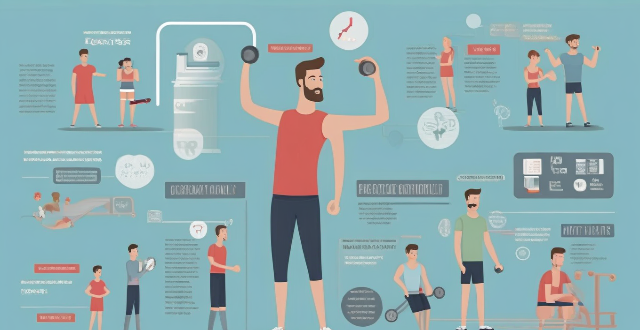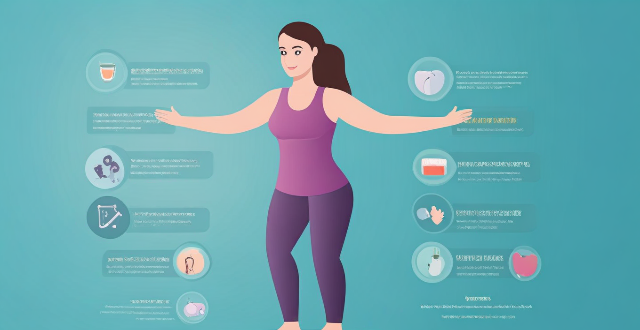Exercise Stretching

Can stretching after exercise prevent muscle soreness ?
Stretching after exercise can help reduce muscle soreness and improve flexibility, but it is important to wait for enough time, choose appropriate stretches, be mindful of pain, and use proper technique.

Can stretching before exercise help prevent sports injuries ?
Stretching before exercise is believed to prevent sports injuries by improving flexibility and range of motion, but its effectiveness is debated due to limited scientific evidence. While some studies suggest stretching may increase injury risk, many experts still recommend it as part of an exercise routine. To stretch safely, warm up first, hold stretches for at least 30 seconds, avoid bouncing, focus on major muscle groups, and listen to your body's signals.

Is it true that stretching before workout prevents injuries ?
Stretching before a workout is a common practice, but does it prevent injuries? Recent studies suggest that static stretching may actually decrease performance and increase the risk of injury. Dynamic stretching, on the other hand, appears to be more effective at reducing the risk of injury. Incorporating dynamic stretching and light aerobic activity into your warm-up routine can help prepare your body for exercise and reduce the risk of injury.

What is the role of stretching in physical recovery and injury prevention ?
Stretching is an essential component of any physical activity routine, including sports, exercise, and daily activities. It helps to improve flexibility, range of motion, and overall mobility. In this article, we will explore the role of stretching in physical recovery and injury prevention. The benefits of stretching include improved range of motion, improved joint mobility, and improved post-exercise recovery. By increasing flexibility and range of motion, stretching can help reduce the risk of strain injuries such as hamstring pulls or calf strains. Stretching can also help to reduce the risk of overuse injuries, which are common in sports that involve repetitive movements or high levels of exertion. Additionally, stretching can help improve balance and coordination, reducing the risk of falls and other accidents. To stretch properly, it's important to warm up before exercise with some light stretching to prepare your muscles for the workout and reduce the risk of injury. After finishing your exercise, stretch again to speed up recovery time and reduce muscle soreness. You should hold each stretch for at least 30 seconds and go through all major muscle groups. When you stretch, use proper techniques to avoid putting unnecessary stress on your muscles or joints. Stretch slowly and gently, avoiding any sudden or forceful movements.

Can stretching after a workout improve flexibility ?
Stretching after a workout can improve flexibility, reduce muscle soreness, and aid in recovery. To stretch properly, hold each stretch for at least 30 seconds, avoid bouncing, and focus on major muscle groups.

What are the benefits of post-workout stretching ?
The article discusses the benefits of post-workout stretching, including improved flexibility, reduced muscle soreness, increased circulation, and injury prevention. It emphasizes that stretching after a workout is an essential part of any fitness routine and can lead to better overall health.

Can stretching alone be an effective warm-up for athletes ?
Stretching alone may not be sufficient as a warm-up for athletes due to limited cardiovascular benefits, insufficient muscle activation, and potential risks associated with static stretching. An effective warm-up should include dynamic stretching, sport-specific movements, gradual progression, and sufficient time to adequately prepare the body for physical activity and reduce the risk of injury.

How does stretching help with recovery after a workout ?
Stretching is crucial for recovery after a workout. It improves blood circulation, reduces muscle soreness and stiffness, enhances flexibility, promotes better range of motion, prevents injury, and reduces stress. Incorporating stretching into your post-workout routine can greatly enhance your recovery process.

Is it better to stretch before or after a workout ?
Stretching is an essential component of any exercise routine. It helps to improve flexibility, reduce the risk of injury, and enhance overall performance. However, there has been a long-standing debate about whether it is better to stretch before or after a workout. In this article, we will explore both sides of the argument and provide our recommendations based on current research. Stretching Before a Workout: Advantages include warm-up for muscles and potential injury prevention. Disadvantages may include reduced strength and overstretching. Stretching After a Workout: Advantages include improved flexibility and aiding in recovery. Disadvantages may include delayed onset muscle soreness (DOMS). Recommendations: Based on current research, both pre- and post-workout stretching have their benefits and drawbacks. Perform dynamic stretches before exercise to warm up your muscles without compromising strength or power output. Incorporate static stretches after your workout to improve flexibility and aid in recovery. Make stretching a regular part of your exercise routine for consistent improvements in flexibility and overall performance.

How can I incorporate stretching into my gym routine ?
Stretching is essential for any fitness routine. It improves flexibility, reduces injury risk, and enhances performance. Here are tips on incorporating stretching into your gym routine: dynamic stretches before workouts, foam rolling, active isolation stretches during workouts, resistance band stretches, static stretches after workouts, yoga or Pilates, and cooldown stretches. Incorporating stretching into your routine will help you reap the benefits of a well-rounded fitness regimen.

How can I incorporate stretching into my daily office routine ?
Incorporating stretching into a daily office routine is crucial for maintaining good posture, preventing muscle stiffness, and reducing the risk of work-related injuries. Here are some tips to help you add stretching to your daily routine: Start with a warm-up: Begin your day with simple warm-up exercises like shoulder shrugs, arm circles, and neck rolls. Take breaks to stretch: Set an alarm or use a timer app to remind yourself to take short breaks throughout the day to stretch your wrists, back, and legs. Use your lunch break wisely: Take advantage of your lunch break to do a more comprehensive stretching session. Find a quiet space where you won't be disturbed and stretch your hamstrings, quads, and calves. End your day with cool-down stretches: Before leaving the office, take a few minutes to cool down and stretch out any tight muscles that have developed during the day. Stretch your chest, hip flexors, and shoulders. Remember to listen to your body and only stretch to the point of mild discomfort. Never force a stretch or bounce, as this can lead to injury. By incorporating these simple stretching exercises into your daily office routine, you'll improve your overall well-being and increase productivity at work.

How can sports education help prevent injuries and promote safe exercise habits ?
Sports education is crucial for preventing injuries and promoting safe exercise habits. It emphasizes proper warm-up and cool-down exercises, correct technique and form, safety equipment and gear, stretching and flexibility, hydration and nutrition, and rest and recovery. By providing athletes with the necessary knowledge, skills, and attitudes, sports education helps them avoid common mistakes that lead to injuries and develop healthy exercise routines.

What are some common mistakes people make after intense exercise
Ignoring proper nutrition, not stretching, overtraining, drinking too much water and skipping breakfast are all common mistakes people make after intense exercise. It's important to replenish your body with nutrients it needs to recover and repair itself, stretch to prevent muscle soreness and stiffness, give your body enough rest and recovery time between workouts, drink enough water but not too much, and eat a healthy breakfast to refuel your body.

Is it necessary to stretch every muscle group after a workout ?
Stretching after a workout is often considered an essential part of any exercise routine. It helps in improving flexibility, reducing muscle soreness, and preventing injuries. However, the question remains: is it necessary to stretch every muscle group after a workout? Let's delve into this topic and explore the benefits and considerations associated with post-workout stretching.### Importance of Post-Workout Stretching Improved Flexibility Stretching after a workout can help maintain and improve flexibility over time. When muscles are warmed up from the exercise, they become more pliable, making it easier to stretch them. Regular stretching can lead to increased range of motion and better overall flexibility. Reduced Muscle Soreness Stretching can help reduce muscle soreness that may occur after a strenuous workout. By elongating the muscles, stretching promotes blood flow, which aids in the removal of lactic acid and other waste products that contribute to muscle soreness. Injury Prevention Stretching can also play a role in injury prevention. By increasing flexibility and range of motion, stretching can help reduce the risk of strains, sprains, and other injuries that may occur during physical activity.### Considerations for Post-Workout Stretching Not All Muscles Need to Be Stretched While stretching is generally beneficial, it's not necessary to stretch every muscle group after every workout. The focus should be on the muscles that were primarily engaged during the exercise session. For example, if you completed a lower body workout, it would be more beneficial to stretch your legs rather than your arms. Quality Over Quantity It's important to prioritize the quality of your stretches over the quantity. Performing a few well-executed stretches is more effective than rushing through multiple stretches without proper form or technique. Take the time to hold each stretch for at least 15-30 seconds, ensuring that you feel a gentle stretch without any pain or discomfort. Listen to Your Body Your body will provide clues about which muscles need stretching. If you experience tightness or stiffness in a particular muscle group, it's a good idea to focus on stretching those areas. Conversely, if a muscle group feels loose and relaxed, there may be no need to stretch it extensively.### Conclusion In conclusion, while stretching every muscle group after a workout is not strictly necessary, incorporating stretching into your post-workout routine can offer numerous benefits. By focusing on the muscles that were heavily engaged during your exercise session and prioritizing quality over quantity, you can improve flexibility, reduce muscle soreness, and potentially prevent injuries. Remember to listen to your body and adjust your stretching routine accordingly for optimal results.

Is it safe to exercise during pregnancy and what precautions should be taken ?
Is it safe to exercise during pregnancy? Yes, as long as you follow certain precautions and guidelines, including consulting your healthcare provider, choosing appropriate exercises, listening to your body, staying hydrated, wearing comfortable clothing, using proper technique, avoiding lying flat on your back, not pushing yourself too hard, cooling down properly, and being mindful of environmental factors. Exercise can have numerous benefits for pregnant women, such as reducing the risk of gestational diabetes, improving mood, increasing energy levels, and helping with recovery after birth.

How does exercise physiology help in preventing sports injuries ?
Exercise physiology helps prevent sports injuries by understanding body mechanics, energy systems, and recovery needs. Athletes can reduce injury risk through proper warm-up/cool-down, cross-training, progressive overload, and sufficient recovery time.

Are there any age-related considerations when using exercise to prevent chronic diseases ?
Age-related considerations for using exercise to prevent chronic diseases include cardiovascular health, musculoskeletal health, balance and coordination, and cognitive health. Exercise intensity should be adjusted based on maximum heart rate, and low-impact exercises are recommended for joint pain. Weight-bearing exercises can help reduce the risk of osteoporosis. Balance and coordination exercises can reduce the risk of falls, and stretching can maintain flexibility. Regular exercise can also improve cognitive function and alleviate symptoms of depression and anxiety in older adults.

Can exercise prevent osteoporosis ?
Exercise plays a crucial role in maintaining healthy bones by increasing bone density and strength. Effective exercises for preventing osteoporosis include weight-bearing exercises, strength training, balance exercises, high-impact exercises, and flexibility exercises. Incorporating these exercises into your routine can help reduce the risk of osteoporosis and maintain strong bones throughout your life.

How much exercise is needed to improve sleep ?
The text discusses the importance of regular physical activity in improving sleep quality. It highlights how exercise can lead to better sleep patterns, faster sleep onset, deeper sleep, and improved sleep efficiency. The amount of exercise needed varies depending on individual factors, but general guidelines suggest at least 150 minutes of moderate-intensity aerobic exercise per week. Even small amounts of physical activity can have positive effects on sleep. Various types of exercise, including aerobic exercises, resistance training, yoga, and Pilates, can contribute to improved sleep quality. Timing your exercise sessions appropriately is crucial for maximizing their benefits for sleep improvement. Consistency is key when it comes to reaping the benefits of exercise on sleep quality.

Why is it important to stretch after exercising ?
Stretching after exercising is crucial for preventing injuries, enhancing performance, and promoting recovery. It improves flexibility, reduces muscle soreness, prevents injuries, promotes recovery, enhances performance, and reduces stress. Incorporating stretching into your fitness routine will improve your overall health and make your workouts more enjoyable and effective.

How can I incorporate aerobic exercise into my daily routine ?
Incorporating aerobic exercise into your daily routine can improve cardiovascular health, burn calories, and enhance mood and energy levels. Here are ways to seamlessly incorporate aerobic exercise into your day: 1. **Morning Vigor**: Start the day with activities like jogging, cycling, or jump roping. 2. **Lunch Break Activities**: Use your lunch break for stair climbing, walking meetings, or yoga. 3. **Post-Work Energy Booster**: After work, engage in gym sessions, outdoor sports, or dancing. 4. **Evening Wind-Down**: Before bedtime, consider gentle exercises like evening walks, Tai Chi, or swimming. 5. **Weekend Adventures**: On weekends, engage in longer duration exercises like hiking, biking, or water sports. 6. **Lifestyle Integration**: Make aerobic exercise a habit by commuting actively, doing active errands, or using fitness trackers.

Can exercise help reduce common pregnancy discomforts like back pain and swelling ?
Exercise can help alleviate common pregnancy discomforts like back pain and swelling by strengthening core muscles, improving posture, enhancing flexibility, promoting circulation, and reducing fluid retention. However, it's important to consult with a healthcare provider before starting any exercise program during pregnancy and follow safety precautions such as starting slowly, avoiding high-impact activities, staying hydrated, and listening to your body.

What should I do if I experience pain during exercise ?
Pain during exercise can be a sign of injury or overexertion. To prevent and manage pain, it is important to warm-up properly, stretch regularly, pay attention to your body's signals, incorporate cross-training, take breaks, drink plenty of water, use proper form, rest and recover, and seek medical advice if necessary. By following these steps, you can reduce the risk of injury and improve your overall fitness.

How often should women exercise to see results ?
Exercising regularly is crucial for women's health, and the recommended frequency varies based on the type of exercise. Cardiovascular exercises are recommended at least 150 minutes per week, while strength training should be done at least twice a week. Flexibility and balance exercises should be included in the routine at least once a week. Various factors such as age, goals, fitness level, lifestyle, and health conditions can impact the effectiveness of the workout routine. It is essential to listen to your body and adjust your exercise routine accordingly to achieve optimal results and maintain a healthy lifestyle.

How much exercise do I need to maintain good cardiovascular health ?
Maintaining good cardiovascular health requires regular exercise, with the American Heart Association recommending at least 150 minutes of moderate-intensity aerobic activity or 75 minutes of vigorous-intensity aerobic activity each week, along with two or more days of muscle-strengthening activities. The amount of exercise needed may vary depending on individual needs and fitness level, and other lifestyle factors such as diet, stress management, sleep, and avoiding smoking and excessive alcohol consumption can also contribute to good cardiovascular health.

How does regular exercise contribute to occupational health ?
**Summary: Regular Exercise in Occupational Health** The article discusses the role of regular exercise in promoting occupational health, which encompasses physical, mental, and social well-being. It outlines the benefits of regular physical activity, including improved stamina, reduced injury risk, enhanced immune system, stress reduction, better cognitive function, increased resilience, team building, and a healthy work-life balance. The text emphasizes that incorporating exercise into daily routines can significantly enhance job performance and overall employee well-being. Employers are encouraged to implement wellness programs with exercise initiatives to foster a healthier and more productive workforce.

How long should I hold each stretch after a workout ?
Stretching after a workout is crucial for reducing muscle soreness, improving flexibility, and preventing injuries. The recommended duration for each stretch varies depending on the type of stretching: - Static stretching: Hold each stretch for 15-30 seconds and repeat 2-4 times. - Dynamic stretching: Perform 8-12 repetitions per stretch and 1-2 sets. To make the most out of your post-workout stretching routine, focus on breathing, avoid bouncing, listen to your body, and be consistent.

Patients with fatty liver should exercise reasonably and choose the most suitable exercise for themselves

How does exercise benefit the health of older adults ?
Exercise plays a crucial role in maintaining the health and well-being of older adults. Regular physical activity can significantly improve their quality of life by preventing diseases, promoting longevity, and enhancing mental health. This text discusses the various benefits of exercise for seniors, including improvements in strength, endurance, mobility, balance, chronic disease management, stress reduction, emotional health, cognitive functioning, social interaction, independence, and overall quality of life. Engaging in regular physical activity is one of the most effective ways for seniors to maintain a healthy and fulfilling lifestyle as they age.